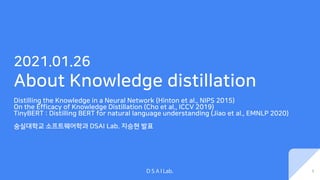
(in Korean) about knowledge distillation
- 1. D S A I Lab. 2021.01.26 About Knowledge distillation Distilling the Knowledge in a Neural Network (Hinton et al., NIPS 2015) On the Efficacy of Knowledge Distillation (Cho et al., ICCV 2019) TinyBERT : Distilling BERT for natural language understanding (Jiao et al., EMNLP 2020) 숭실대학교 소프트웨어학과 DSAI Lab. 지승현 발표 1
- 2. D S A I Lab. 목차 1. Knowledge distillation 개요 2. Characteristics of Knowledge distillation – 빠른 수렴 및 학습 방해 – 좋은 Teacher model의 조건 – Attention transfer 3. BERT distillation 4. 결론 2
- 3. D S A I Lab. 1. Knowledge distillation 개요 – Knowledge distillation : 잘 학습된 대형 모델을 사용, 소형 모델에 지식을 증류 – Teacher model과 Student model를 가정 – Input에 대한 Teacher model의 출력을 흉내내도록 Student model을 학습 이를 통해 Student model을 처음부터 학습 (from scratch) 하는것보다 성능을 높이는 것이 목표 3
- 4. D S A I Lab. 1. Knowledge distillation 개요 – 일반 학습 Loss과의 차이점 – 정답을 one-hot vector 형태의 “Hard Target” 으로 변환하는 것이 통상적 – 이 때 one-hot vector와 cross-entropy를 수행 – 그러나 Knowledge distillation (이하 KD) Loss 는 Soft target에 대한 경우가 많음. 4 클래스 정답확률 q_1 0 q_2 0 … … q_i 1 클래스 정답확률 q_1 0.1 q_2 0.05 … … q_i 0.6 일반 학습 Loss KD Loss
- 5. D S A I Lab. 1. Knowledge distillation 개요 – Hinton et al. 은 Teacher Model 출력에 Temperature를 제안 (2015) – Temperature이란 출력 결과를 더 부드럽게 만들어주는 기법 – 이를 통해 Teacher model의 출력 결과 정보를 더 잘 전달할 수 있다고 주장 – 𝒒𝒊가 Teacher model의 출력 확률, 𝒛𝒊가 클래스 i에 대한 활성화 이전 출력값이라면 𝒒𝒊 = 𝒆𝒙𝒑 𝒛𝒊/𝑻 𝒋 𝒆𝒙𝒑 𝒛𝒋/𝑻 에서 𝑻 = Temperature 5 (임의 예시) 클래스 정답확률 q_1 0.1 q_2 0.05 … … q_i 0.6 클래스 정답확률 q_1 0.15 q_2 0.07 … … q_i 0.5
- 6. D S A I Lab. 1. Knowledge distillation 개요 – 통상적인 KD는 KD Loss에 일반 Loss를 섞은 함수로 학습하는 방법을 지칭 – 𝒒𝒊 = 𝒆𝒙𝒑 𝒛𝒊/𝑻 𝒋 𝒆𝒙𝒑 𝒛𝒋/𝑻 , 𝒑𝒊는 Student Model의 출력 확률일 때 ℒ𝑲𝑫 = −𝑻𝟐 𝒌 𝒒𝒌 𝒍𝒐𝒈𝒑𝒌 ℒ = 𝜶ℒ𝑲𝑫 + (𝟏 − 𝜶)ℒ𝑪𝑳𝑺 – 이 때 𝜶는 Hyperparameter, ℒ𝑪𝑳𝑺는 일반 학습에서의 loss – 통상적으로 𝜶=0.9, 𝑻 ∈ {𝟑, 𝟒, 𝟓} 6
- 7. D S A I Lab. 2. Characteristics of Knowledge distillation (1) – KD loss는 빠르게 학습시키지만, 점점 성능향상을 방해한다.* – From scratch 학습 시보다 빠르게 수렴된다. (좌) – 그러나 일정 반복 (epoch) 수를 넘어서면 KD의 수렴이 더 느려진다. (좌) – 따라서 일정 epoch까지만 KD로 학습 후 일반 학습으로만 진행하는 방법 (ESKD) 이 효과적. (우) 7
- 8. D S A I Lab. 2. Characteristics of Knowledge distillation (2) – 좋은 Teacher는 용량이 크거나 정확도가 높은 모델이 아님 – 오히려 용량이 적은 Teacher 모델이 distillation을 더 잘 수행한 것으로 나타남 (좌) – distillation 성능과 Teacher 모델 용량은 비례하지 않으며 최적 용량이 존재하는 것으로 파악 (우) – Teacher 모델의 정확도보다는 세밀함이 더 중요한 것이라는 주장도 존재* 8 * Muller et al., NIPS 2019
- 9. D S A I Lab. 2. Characteristics of Knowledge distillation (3) – 출력값 뿐만이 아니라 Attention Layer를 전달할 필요가 있다. – Attention Transfer* 는 Teacher의 Attention layer를 Student가 모방하도록 하는 방법 (좌) – j번째 Student의 attention layer (𝑸𝑺 𝒋 ) 와 Teacher의 attention layer (𝑸𝑻 𝒋 ) 를 근사 (우) – 이를 위해 Normalized된 형태 ( 𝑸 𝑸 𝟐 ) 를 사용하고, Student – Teacher의 차를 Loss 함수에 삽입 – ESKD와 함께 적용시 추가적으로 KD 성능이 향상되는 것으로 확인 9 * Zagoruyko et al., ICLR 2017
- 10. D S A I Lab. 3. BERT distillation – TinyBERT는 KD Loss만을 고려한 distillated 모델 – BERT에 KD를 적용한 사례 – Attention transfer를 차용, KD Loss를 Layer Loss로 전환 – Layer Loss만을 사용하여 학습 (ESKD는 미사용) – g(m) 을 통해 Teacher Layer를 Student Layer에 적절히 매핑 10 * https://jalammar.github.io/illustrated-transformer/ 여러 Layer의 BERT의 구조*
- 11. D S A I Lab. 3. BERT distillation – Layer의 인덱스에 따라 Loss 함수의 성격이 변화 – Student의 Layer가 총 M개, Loss 함수를 계산중인 인덱스가 m일 때, 11 간략화한 BERT의 구조
- 12. D S A I Lab. 3. BERT distillation – 본 KD 방법의 우수성을 실험을 통해 확인 1) 언어모델 학습 (Pretrain) 시에 KD 적용시 Student의 성능은 더 나빠짐 2) 그러나 각 태스크에 대해 학습 (Fine-tune) 시에 KD를 적용하면 Student의 성능이 더 좋아짐 1) 동일 파라미터 수로 학습된 소형 BERT 모델보다 더 좋은 성능을 나타냄 2) Teacher 모델보다 파라미터가 적더라도 성능은 거의 유사 * 성능 측정은 언어모델의 성능을 11종의 태스크로 평가하는 GLUE benchmark 사용 12
- 13. D S A I Lab. 4. 결론 – 요약 : – Knowledge distillation은 이미 학습된 모델을 활용하여 경량화된 모델을 더 빠르게 학습 – 그러나 단순 출력값만을 이용하면 더 나쁜 결과를 초래 – 학습된 모델의 가중치 값까지 활용하면 from scratch 학습보다 좋은 결과로 이어짐 – 발표자의 사견: – 대체어 추출이 가능한 언어모델은 모델의 P() 출력이 현실의 P()와 더 가까워진다고 가정 – 이를 통해 KD를 수행할 수 있다고 생각하여 공부 – 그러나 생각보다 많은 어려움이 있는 것으로 파악 13
- 14. D S A I Lab. 4. 결론 – 논문 메타분석 (발표자의 사견) – ESKD 방법을 적용한 BERT distillation을 연구할 수 있을 것으로 사료 – 또한 BERT pretraining에서 왜 KD가 작동하지 않는지 연구해볼 만하다고 사료 – 충분한 Layer 수를 가진 신경망 모델은 전방 레이어가 그래디언트의 대부분을 전파한다고 알려짐 (Veit et al., NIPS 2016) – 따라서 Attention transfer 혹은 KD에서 이러한 원리를 차용, 전방 레이어를 흉내내는 모델에 대 해 연구할 수 있을 것으로 사료 14